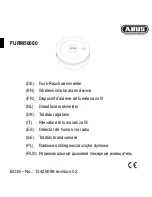
Page 7
DEVELOP AND PRACTICE A PLAN OF ESCAPE
BASICS OF ESCAPE PLAN
o Make a floor plan indicating all doors and windows and at least two escape routes from each
room. Second story windows may need a rope or chain ladder.
o Have a family meeting and discuss your escape plan, showing everyone what to do in case of
fire.
o Determine a place outside your home where all of you can meet if a fire occurs.
o Familiarize everyone with the sound of the smoke alarm and train them to leave your home when
they hear the sound.
o Identify children's bedrooms with red stickers placed in the upper left corner of the windows. They
are available from your local fire department.
o Practice a fire drill at least every six months. Practice allows you to test your plan before an
emergency. You may not be able to reach your children. It is important they know what to do!
WHAT TO DO WHEN THE ALARM SOUNDS
o Leave immediately by your plan of escape. Every second counts, so don't waste time getting
dressed or picking up valuables.
o In leaving, don't open any inside door without first feeling its surface. If hot, or if you see smoke
seeping through cracks,
don't open that door!
Instead, use your alternate exit. If inside door is
cool, place your shoulder against it, open it slightly and be ready to slam it shut if heat and smoke
rush in.
o Stay close to the floor if air is smoky. Breathe shallowly through a cloth, wet if possible.
o Once outside, go to your selected meeting place and make sure everyone is there.
o Call the fire department from your neighbor's home –
not from yours!
o Don't return to your home until fire officials say that it is all right to do so.
NATIONAL FIRE PROTECTION ASSOCIATION REQUIRED INFORMATION
For your information, the National Fire Alarm Code, NFPA 72, reads as follows:
"11.5.1 *Required Detection - Where required by applicable laws, codes, or standards for a specific
type of occupancy, approved single and multiple-station smoke alarms shall be installed as follows:
(1) *In all sleeping rooms and guest rooms
(2) *Outside of each separate dwelling unit sleeping area, within 6.4 m (21 ft) of any door to a
sleeping room, the distance measured along a path of travel
(3) On every level of a dwelling unit, including basements.
(4) On every level of a residential board and care occupancy (small facility), including basements
and excluding crawl spaces and unfinished attics
(5) *In the living area(s) of a guest suite
(6) In the living area(s) of a residential board and care occupancy"
The equipment should be installed using wiring methods in accordance with the
National Fire Protection Association's Standard 72.
(National Fire Protection Association, Batterymarch Park, Quincy, MA 02269)
CAUTION (AS REQUIRED BY THE CALIFORNIA STATE FIRE MARSHAL)
"Early warning fire detection is best achieved by the installation of fire detection equipment in all
rooms and areas of the household as follows. A smoke alarm installed in each separate sleeping
area (in the vicinity of, but outside of the bedrooms), and heat or smoke detectors in the living
rooms, dining rooms, bedrooms, kitchens, hallways, attics, furnace rooms, closets, utility and storage
rooms, basements and attached garages.



























